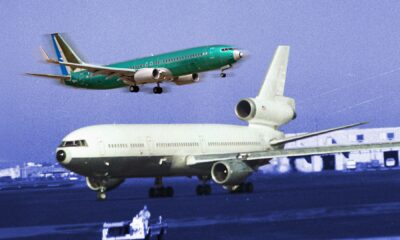World
Boeing’s 737-8ERX: The Long-Range Dream That Never Took Flight

Boeing’s ambitious plans for the long-range variant of its 737 MAX series, known as the 737-8ERX, have not come to fruition as of 2025. Originally envisioned over a decade ago, this aircraft aimed to meet a growing demand for efficient long-haul travel with a narrowbody design. Despite promising initial designs, the 737-8ERX was never built, leaving questions about the reasons behind its cancellation and its potential impact within the competitive aviation landscape.
Increased Capacity and Range
The 737-8ERX was designed to enhance the capabilities of the existing 737 MAX 8, featuring a higher maximum take-off weight (MTOW) of 88.3 tons compared to the 82.2 tons of its predecessor. This modification aimed to support a greater fuel capacity, ultimately extending the aircraft’s range to approximately 4,603 miles. This range would have positioned it favorably against competitors like the Airbus A321XLR, which boasts a maximum range of 5,400 miles.
To achieve these enhancements, Boeing planned to incorporate elements from the larger 737 MAX 9, including wings and landing gear, alongside an additional fuel tank. Such design changes were crucial to ensuring the aircraft’s performance during takeoff and flight.
The Fate of the 737-8ERX
Despite initial ambitions for the 737-8ERX to enter service in the early 2020s, Boeing has not released any prototypes, signaling a shift in focus. Throughout its history, Boeing has explored various aircraft concepts, some of which were publicly disclosed, while others remained confidential. The 737-8ERX appears to have faced insurmountable challenges during the design phase, ultimately leading to its abandonment.
Although the company has confirmed its commitment to innovation and new aircraft studies, it seems that the 737-8ERX simply became unviable within an increasingly crowded marketplace. Issues related to the existing 737 MAX series, coupled with fierce competition from models like the A321XLR, contributed to this decision.
Competition with the Airbus A321XLR
The A321XLR emerged as a direct competitor to the 737-8ERX, offering significant advantages that likely influenced Boeing’s decision to halt development. Launched in 2019, the A321XLR is designed for long-haul routes while maintaining the cost efficiencies typical of narrowbody aircraft. With a range of 5,400 miles, it effectively bridges the gap between narrowbody and widebody operations.
Airbus has equipped the A321XLR with a rear center tank, increasing its fuel capacity without compromising cargo space. Structural reinforcements, such as strengthened landing gear, have also been implemented to support its extended range. Consequently, this aircraft enables airlines to operate longer routes traditionally served by larger aircraft, offering substantial operational flexibility.
The passenger experience aboard the A321XLR is comparable to that of widebody jets, featuring enhanced cabin designs, larger overhead bins, and improved lighting. This level of comfort is vital for longer flights, which can last from seven to nine hours. Furthermore, the A321XLR boasts a fuel efficiency improvement of up to 30% per seat compared to older generation aircraft, aligning with contemporary sustainability goals.
Current Operators of the A321XLR
As of October 2025, only four A321XLR aircraft have been delivered, with operators including Aer Lingus, Iberia, and Qantas. The table below outlines routes currently serviced by the A321XLR:
| Departure Airport | Arrival Airport | Airline |
|——————-|——————|———|
| Madrid Barajas Airport (MAD) | Boston Logan International Airport (BOS) | Iberia |
| Dublin Airport (DUB) | Nashville International Airport (BNA) | Aer Lingus |
| Dublin Airport (DUB) | Indianapolis International Airport (IND) | Aer Lingus |
| Sydney Airport (SYD) | Perth Airport (PER) | Qantas (launching soon) |
Airbus has received more than 500 orders for the A321XLR, showcasing its appeal and market potential.
The Broader Landscape of the 737 MAX Series
Had the 737-8ERX reached production, it would have joined the ranks of the 737 MAX series, which includes the MAX 7, MAX 8, MAX 9, and MAX 10 variants. Launched in 2011 and entering service in 2017, the 737 MAX was developed to enhance fuel efficiency and passenger comfort, responding to growing competition from the A320neo family.
The 737 MAX employs CFM International LEAP-1B engines, which provide approximately 14% better fuel efficiency than earlier models. Currently, the 737 MAX 8 and MAX 9 are the primary models in service, with Southwest Airlines operating the largest fleet, comprising 273 MAX 8s and an additional 510 on order.
In conclusion, the absence of the 737-8ERX illustrates the challenges faced by manufacturers in a rapidly evolving aviation market. With the success of the A321XLR, Boeing appears to have shifted its focus towards other innovative projects, such as the upcoming 777X, as it navigates an increasingly competitive landscape.
-

 Science2 months ago
Science2 months agoUniversity of Hawaiʻi Joins $25.6M AI Project to Monitor Disasters
-

 Business2 months ago
Business2 months agoForeign Inflows into Japan Stocks Surge to ¥1.34 Trillion
-

 Top Stories2 months ago
Top Stories2 months agoBOYNEXTDOOR’s Jaehyun Faces Backlash Amid BTS-TWICE Controversy
-

 World2 months ago
World2 months agoBoeing’s Merger with McDonnell Douglas: A Strategic Move Explained
-

 Top Stories2 months ago
Top Stories2 months agoCarson Wentz Out for Season After Shoulder Surgery: Urgent Update
-

 Entertainment2 months ago
Entertainment2 months agoSydney Sweeney Embraces Body Positivity Amid Hollywood Challenges
-

 Top Stories2 months ago
Top Stories2 months agoMarc Buoniconti’s Legacy: 40 Years Later, Lives Transformed
-

 Lifestyle2 months ago
Lifestyle2 months agoKelsea Ballerini Launches ‘Burn the Baggage’ Candle with Ranger Station
-

 Health2 months ago
Health2 months agoInnovative Surgery Restores Confidence for Breast Cancer Patients
-

 Sports2 months ago
Sports2 months agoSteve Kerr Supports Jonathan Kuminga After Ejection in Preseason Game
-

 Entertainment2 months ago
Entertainment2 months agoZoe Saldana Advocates for James Cameron’s Avatar Documentary
-

 Science2 months ago
Science2 months agoChicago’s Viral ‘Rat Hole’ Likely Created by Squirrel, Study Reveals









